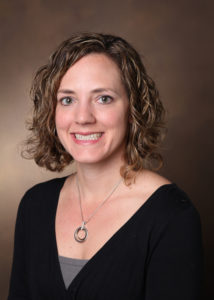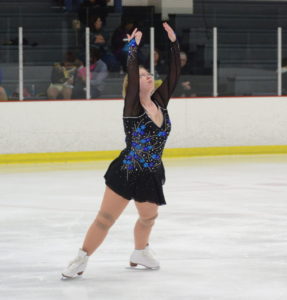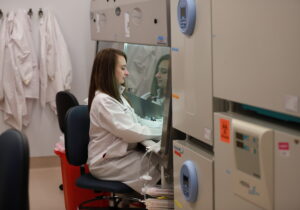Marathon Running, Marathon Research: Dawn Newcomb

For Dawn Newcomb, PhD, writing a grant is like running a marathon. As a veteran of six marathons since she moved to Nashville in 2007, she should know. “You have to be in it for the long haul and pace yourself well,” she says. She found the CTSD grant pacing workshops, which include a 16-week plan, helpful for that. “A lot of races have a 16-week training period, so it was a timetable I was accustomed to.”
Dr. Newcomb, who recently received an R01 from NHLBI, studies the role of sex hormones estrogen and progesterone in severe asthma. Currently, she uses cells that circulate in the blood from patients with severe asthma and healthy individuals as well as a mouse model to study the mechanism by which these hormones regulate the production of a protein, IL-17A, that mediates the inflammation in this particular type of asthma. In this way, she hopes to discover a mechanism to explain exactly why women are more likely to have severe asthma than men as adults.
“Asthma used to be thought of as this big umbrella,” she says. “If you had asthma, you were going to be treated with the same medications, regardless of what kind of asthma you had.” However, asthma varies widely among sufferers, from those who have to go to the ER when they get a cold to those who may simply have to use an inhaler once or twice during the week. In the past, asthma medications have been tested on patients within a broad category, and many of these patients did not have the type of asthma the medication targeted. Newcomb hopes her research findings will lead to a more precise understanding of mechanisms leading to inflammation in severe asthmatics and will help determine which patients may respond to different therapeutics targeting severe asthma.
Newcomb’s focus on sex hormones and asthma developed as a way to optimally position herself for funding. She had been working broadly to discover exactly how IL-17 causes asthma. When the Building Interdisciplinary Research Careers in Women’s Health (BIRCWH) K12 called for applications in 2012, she knew she wanted to apply, but had to make her work relevant to the grant’s stated focus on sex and gender differences. She wondered if IL-17 might work differently in men and women, and ran assays to determine if there was a difference in IL-17A production between CD4+ Th17 cells from women and men. “Lo and behold, there was a significant increase in IL-17A production in CD4+ Th17 cells from women compared to men.” This difference was the cornerstone of her successful BIRCWH application, and guided her research in the direction of her current R01.
In the midst of grant-writing and research, Newcomb finds that marathon training, and exercise in general, keeps her sane. When you’re in it for the long haul, you have to figure out “ways to clear your mind, loosen your shoulders” and concentrate on other things for a while. As well, support from those around her, including her husband, Jeff, her family, her friends, and mentor, Stokes Peebles, makes the process survivable—even when that support is to have a draft come back so marked up it’s hard to read.
“Understand everyone’s trying to help you. No one’s trying to diminish your intelligence, your work, or your research. It’s hard to remember this advice when a draft comes back with more red ink than black ink on it. So I just stick it in my bag for a day or two and pull it out at a time when I’m not as close to it.” The corollary to that, she notes, is that you have to give mentors and others time to read and help. And, much like plotting out a race training schedule, you have to give yourself time “to pull it all apart and put it back together.”
Writing a big grant isn’t a sprint. But like a marathon, with proper pacing and good support, you can cross the finish line.
For Dawn Newcomb, PhD, writing a grant is like running a marathon. As a veteran of six marathons since she moved to Nashville in 2007, she should know. “You have to be in it for the long haul and pace yourself well,” she says. She found the CTSD grant pacing workshops, which include a 16-week plan, helpful for that. “A lot of races have a 16-week training period, so it was a timetable I was accustomed to.”
Dr. Newcomb, who recently received an R01 from NHLBI, studies the role of sex hormones estrogen and progesterone in severe asthma. Currently, she uses cells that circulate in the blood from patients with severe asthma and healthy individuals as well as a mouse model to study the mechanism by which these hormones regulate the production of a protein, IL-17A, that mediates the inflammation in this particular type of asthma. In this way, she hopes to discover a mechanism to explain exactly why women are more likely to have severe asthma than men as adults.
“Asthma used to be thought of as this big umbrella,” she says. “If you had asthma, you were going to be treated with the same medications, regardless of what kind of asthma you had.” However, asthma varies widely among sufferers, from those who have to go to the ER when they get a cold to those who may simply have to use an inhaler once or twice during the week. In the past, asthma medications have been tested on patients within a broad category, and many of these patients did not have the type of asthma the medication targeted. Newcomb hopes her research findings will lead to a more precise understanding of mechanisms leading to inflammation in severe asthmatics and will help determine which patients may respond to different therapeutics targeting severe asthma.
Newcomb’s focus on sex hormones and asthma developed as a way to optimally position herself for funding. She had been working broadly to discover exactly how IL-17 causes asthma. When the Building Interdisciplinary Research Careers in Women’s Health (BIRCWH) K12 called for applications in 2012, she knew she wanted to apply, but had to make her work relevant to the grant’s stated focus on sex and gender differences. She wondered if IL-17 might work differently in men and women, and ran assays to determine if there was a difference in IL-17A production between CD4+ Th17 cells from women and men. “Lo and behold, there was a significant increase in IL-17A production in CD4+ Th17 cells from women compared to men.” This difference was the cornerstone of her successful BIRCWH application, and guided her research in the direction of her current R01.
In the midst of grant-writing and research, Newcomb finds that marathon training, and exercise in general, keeps her sane. When you’re in it for the long haul, you have to figure out “ways to clear your mind, loosen your shoulders” and concentrate on other things for a while. As well, support from those around her, including her husband, Jeff, her family, her friends, and mentor, Stokes Peebles, makes the process survivable—even when that support is to have a draft come back so marked up it’s hard to read.
“Understand everyone’s trying to help you. No one’s trying to diminish your intelligence, your work, or your research. It’s hard to remember this advice when a draft comes back with more red ink than black ink on it. So I just stick it in my bag for a day or two and pull it out at a time when I’m not as close to it.” The corollary to that, she notes, is that you have to give mentors and others time to read and help. And, much like plotting out a race training schedule, you have to give yourself time “to pull it all apart and put it back together.”
Writing a big grant isn’t a sprint. But like a marathon, with proper pacing and good support, you can cross the finish line.






0 Comments